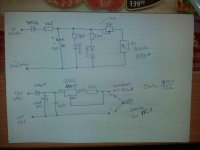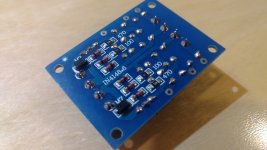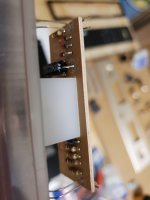True VU meter is effectively a perceived loudness meter.
Watching proper VU meters when playing the likes of AC/DC or REM What's the Frequency Kenneth is informative.
Dan.
Watching proper VU meters when playing the likes of AC/DC or REM What's the Frequency Kenneth is informative.
Dan.
The key word there is "may". But I doubt it. Looking at what most people on this forum listen to, it much more likely about 16dB of range, if that much. 😉More to the point: you may listen with forte passages down at 65dB SPL (background music) or 105dB SPL (LOUD!), with softer passages 20 to 50 dB lower. So over 40dB range of listening levels.
I do agree that the VU meter doesn't really have enough range for what is intended here. Getting into a range that gives good visuals is going to be tricky. But it will be a good indication of dynamics, if he can get it dialed in.
Here's a thought. Stick the meter on the output of you CD player or your preamp. Better yet, the headphone out which will have adjustable volume - then take a look at what you get.
I would be surprised if the meter had inbuilt rectification.
This topic crops up quite often on here and this was a simple circuit I threw together to take a short duration AC signal (such as a transient in music) and produce a DC voltage that can be used to drive a meter. You can set the decay time by fiddling with the cap values to suit the meter and the visual effect you desire.
Having the diode within the feedback loop eliminates the forward volt drop of the device, the bane of passive networks.
Its all textbook stuff, nothing original 🙂
This topic crops up quite often on here and this was a simple circuit I threw together to take a short duration AC signal (such as a transient in music) and produce a DC voltage that can be used to drive a meter. You can set the decay time by fiddling with the cap values to suit the meter and the visual effect you desire.
Having the diode within the feedback loop eliminates the forward volt drop of the device, the bane of passive networks.
Its all textbook stuff, nothing original 🙂
Attachments
Essentially yes although if you examine a music waveform you will see the average is zero, in other words there are similar positive and negative going peaks.
The addition of a another opamp as a buffer at the output, and changing the input opamp to inverting configuration would create a full wave version, and still only using one diode.
The addition of a another opamp as a buffer at the output, and changing the input opamp to inverting configuration would create a full wave version, and still only using one diode.
I would be surprised if the meter had inbuilt rectification.
SURPRISE! It does. It is a model NISSEI TN-73 ROSH Panel VU Meter 0.8VAC. Actually designed to be used with a resistor of 3,600 ohms to give a "0" reading at 1.228 Volts RMS AC.
Essentially yes although if you examine a music waveform you will see the average is zero, in other words there are similar positive and negative going peaks.
Second SURPRISE! It uses a full wave bridge. A drum hit is an example of a not very symmetric waveform. The average may go to zero but absolute phase really does exist.
Last edited:
Interesting. So it would/should make a good candidate to wrap an opamp around to overcome the diode drops. Good stuff 

Good find! Nice that it has built in rectification. Put a 3K6 in front of it and connect it to the CD player outputs. Should be some action there.
The listing even says "no rectifier needed". (But then says something about 5U4??)
A related listing IS intended for loudspeaker monitoring: LINK
60+dB range from <1mW to 300Watts. (A little odd that 100W to 300W is 6dB?)
A comment says this is a raw meter, not the pretty panel shown. $19 for a near-LOG meter is a good price; $19 for that nice-nice panel is expecting too much.
A related listing IS intended for loudspeaker monitoring: LINK
60+dB range from <1mW to 300Watts. (A little odd that 100W to 300W is 6dB?)
A comment says this is a raw meter, not the pretty panel shown. $19 for a near-LOG meter is a good price; $19 for that nice-nice panel is expecting too much.
A VU meter is for line level signals not amp outputs. It's not a power meter. It measures voltage. Since speaker impedance can vary a lot with freq. so dose the amp power at a constant output voltage. The power output at the speaker resonance is a fraction of that at other freqs. even thou the VU shows the same reading.
Last edited:
On his garage wall, my father has a pair of original Weston type VU meters mounted on a panel.
The source signal is tape output fedc into a volume control, rotary switch and an opamp stage feeding the meters via 3.6k resistor.
The switch selects variable sensitivity (vol pot) or preset absolute sensitivity.
The preset level is very useful for checking radio modulation levels and cdp output levels.
Both settings are useful for informative visual listening.
This arrangement could of course be connected to amplifier speaker outputs and a volume control or range switching set to provide appropriate sensitivity according to listening level.
The VU meter is useful for those trained in using it and indicates average levels and ignores short term transient signals.
The attack/decay characteristics effectively cause smoothing that corresponds quite well to perceived loudness.
It is interesting to watch a 'proper' VU meter displaying rock/pop music.
The REM track and some AC/DC tracks are interesting as a study on how highly compressed and limited such music can be and still portray textures and separation of instruments etc.
IIRC the REM track sits on essentially constant level for most of the song with a few dips of one dB or so, same with a couple of AC/DC tracks.
VU meters done right are fun to have around.
Dan.
The source signal is tape output fedc into a volume control, rotary switch and an opamp stage feeding the meters via 3.6k resistor.
The switch selects variable sensitivity (vol pot) or preset absolute sensitivity.
The preset level is very useful for checking radio modulation levels and cdp output levels.
Both settings are useful for informative visual listening.
This arrangement could of course be connected to amplifier speaker outputs and a volume control or range switching set to provide appropriate sensitivity according to listening level.
The VU meter is useful for those trained in using it and indicates average levels and ignores short term transient signals.
The attack/decay characteristics effectively cause smoothing that corresponds quite well to perceived loudness.
It is interesting to watch a 'proper' VU meter displaying rock/pop music.
The REM track and some AC/DC tracks are interesting as a study on how highly compressed and limited such music can be and still portray textures and separation of instruments etc.
IIRC the REM track sits on essentially constant level for most of the song with a few dips of one dB or so, same with a couple of AC/DC tracks.
VU meters done right are fun to have around.
Dan.
Attachments
Ordered one. Will give it a try.
Ordered one. Will give it a try.
I hope they will work, I did not find the data for your instruments (resistance and current for full scale) .
Replace BAT43 with BAT46 schottky diode if you have more than 40W/8ohms amplifier.
Last edited:
received my board
It looks very different than what is on the AliExpress page. I wonder what the schematic is for this PCB. It seems to have more diodes.. maybe an improved version?
I will try to trace the board to get the schematic
It looks very different than what is on the AliExpress page. I wonder what the schematic is for this PCB. It seems to have more diodes.. maybe an improved version?
I will try to trace the board to get the schematic
Attachments
Similar type of circuit but now using surface mount parts. Perhaps the extra pair of diodes are reverse biased across the meter for protection (or to absorb eddy currents).
It looks very different than what is on the AliExpress page. I wonder what the schematic is for this PCB. It seems to have more diodes.. maybe an improved version?
I will try to trace the board to get the schematic
Have you discovered the schematic of this new PCB?
Just bought a couple of these VU meters and was wondering how I should wire them in to my LM3886 Gainclone Amp. Cheers
Attachments
- Status
- Not open for further replies.
- Home
- Source & Line
- Analog Line Level
- Correct way to connect VU Meter








